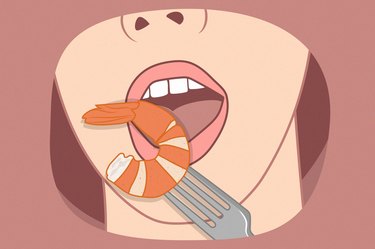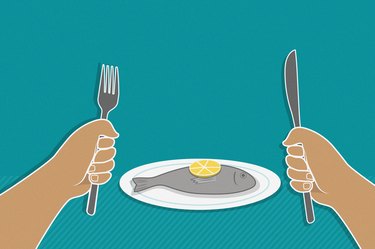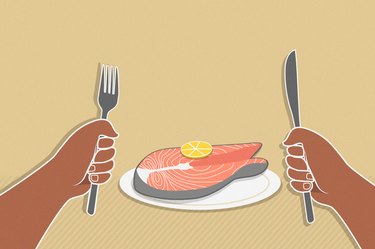
Believe it or not, shrimp is the most-eaten seafood in the United States, per the National Oceanic and Atmospheric Administration Fisheries.
Despite its popularity, there are a few reasons people avoid this seafood: For starters, the contaminants and cholesterol in shrimp are two concerns. Then, add in the serious questions about farming and harvesting and you may be wondering if shrimp is bad for you.
Video of the Day
Video of the Day
But, even with the downsides, there are plenty of benefits to snacking on this tasty crustacean. "In addition to being a healthy protein option, shrimp is a great source of selenium, copper and B12, which are all important in many parts of metabolism," says Amanda Lane, RD, CDCES, founder of Healthful Lane Nutrition.
Here's what you need to know about shrimps' health risks, benefits and how to pick quality seafood.
Risks of Eating Shrimp
Just like all animal products, there are a few health and sustainability concerns with eating shrimp.
1. Shrimp Is High in Cholesterol
"Shrimp does contain cholesterol — a 3-ounce serving has a similar amount of cholesterol as an egg — but research has shown that cholesterol in foods does not impact our cholesterol levels that much," says Christina Iaboni, MHSc, RD.
"Foods high in saturated and trans fats are far worse for cholesterol levels."
So, while a 3-ounce serving of shrimp has 180 milligrams of cholesterol — more than double the amount found in the same portion of ground beef — it's much lower in saturated fat, with only 0.4 grams.
The idea that dietary cholesterol can raise your blood cholesterol (and risk for heart disease) comes from the fact that many foods high in cholesterol are also high in saturated fat, per a June 2018 review in Nutrients.
Warning
While dietary cholesterol doesn't usually affect blood cholesterol levels, it could in people with dyslipidemia (a condition characterized by high LDL or high triglycerides), particularly those with diabetes or at risk for heart failure, per a December 2019 report in Circulation. These groups should limit high-cholesterol foods.
2. Shrimp Could Contain Contaminants
Like other types of seafood, shrimp can either be farmed or wild-caught. Each type has its own risks for our health and the environment.
Both farmed and wild-caught shrimp have been found to contain mercury, a chemical that can cause serious health problems such as cognitive and developmental delays in children and impairment to the brain and reproductive system, per a July 2020 study in Food Science and Nutrition.).
While both types have mercury, the amount is low and there isn't a significant difference between farmed or wild-caught shrimp, per the July 2020 Food Science and Nutrition study.
Another potential contaminant in shrimp comes from antibiotics used to keep farmed shrimp alive and healthy. By industry standards, antibiotics must be stopped at a specific date prior to harvesting the shrimp, Lane says.
Even though the rules would ensure all antibiotics are out of the shrimp's system by the time we sit to enjoy a meal, this isn't always the case. Annually, the FDA refuses an average of 29 percent of all shrimp being imported into the United States, with antibiotic residue being the second most common reason for refusal, per a September 2021 study in Current Research in Food Science.
Unfortunately, not all imports are able to be carefully checked for antibiotics. While past studies have found the presence of antibiotic residue, the 68 samples of frozen shrimp from grocery retail stores across the U.S. had no traces of antibiotic residue, per the September 2021 Current Research in Food Science article.
3. Shrimp Is a Common Allergen
Shrimp, along with crab and lobster, are known as shellfish. An estimated seven million people in the U.S. have a shellfish allergy, according to the American College of Allergy, Asthma, and Immunology.
Symptoms of a shellfish allergy can include:
- Stomach pain
- Hives
- Wheezing
- Difficulty breathing
- Dizziness
- Swelling of the lips and tongue
The best option for people allergic to shrimp is to avoid anything that could be contaminated with the crustacean, such as fish stocks, fryer oil in restaurants and seafood flavorings.
The Health Benefits of Shrimp
Despite the risks, shrimp has several health benefits. According to the USDA, a 3-ounce portion of cooked shrimp has:
- Calories: 101
- Total fat: 1.4 g
- Saturated fat: 0.4 g
- Carbohydrates: 1.3 g
- Protein: 19.4 g
- Selenium: 76% Daily Value (DV)
- Vitamin B12: 59% DV
- Copper: 24% DV
- Phosphorus: 21% DV
- Choline: 21% DV
- Niacin: 14% DV
1. It's Low in Calories and High in Protein
"Shrimp is a healthy option as it's a good source of protein and is low in calories," Iaboni says.
You'll get nearly 20 grams of protein for just about 100 calories in a 3-ounce serving of shrimp.
Diets higher in protein can help you feel more full and satisfied, which can help maintain or reach a healthy weight, according to a March 2021 article in the Journal of Obesity and Metabolic Syndrome.
2. It Has Omega-3s
"Shrimp also has some omega-3 fatty acids that are good for our brain health, but it's not as rich in omega-3s as fatty fish like salmon or sardines," says Iaboni.
One 3-ounce serving of cooked shrimp has 0.25 grams of omega-3 fatty acids. The American Heart Association recommends eating 3 grams of omega-3s daily to help lower blood pressure and reduce the risk of heart disease.
In the case of omega-3s, a supplement won't provide the same benefit as eating fish and other seafood like shrimp. People who eat seafood one to four times per week were observed to have a lower risk of dying from heart disease than those who don't. The same results aren't seen in people who take omega-3 supplements but skip the fish, according to the National Institutes of Health.
3. It's High in Antioxidants
It's not only the omega-3s in shrimp that can benefit heart health. Shrimp is also a good source of the antioxidant astaxanthin, which is responsible for their pinkish-orange coloring, per a January 2022 article in Food Science and Nutrition.
Eating foods high in astaxanthin is associated with a reduced risk of heart disease because of the antioxidant's high potential to fight oxidative stress.
The astaxanthin in shrimp may even help protect your skin from environmental damage. Supplementing with astaxanthin prevented skin dryness and the worsening of wrinkles while the placebo group's skin condition significantly worsened due to environmental changes, per a June 2017 study in the Journal of Clinical Biochemistry and Nutrition.
4. It's Low in Mercury
While shrimp does have some mercury, the levels in it likely won't affect your health. Keeping mercury intake as low as possible is essential to avoid damage to the nervous system, kidneys and immune system, especially in children, per the South Carolina Department of Health and Environmental Control.
Shrimp is even safe for pregnant people, as the levels of mercury in shrimp are so low, according to the American Pregnancy Association.
The estimated mercury intake from eating up to three portions of shrimp per week is less than 6 percent of the tolerable weekly intake set by the Joint Expert Committee on Food Additives, per a March 2021 study in Food Control.
How to Pick Quality Shrimp
To choose the best quality shrimp, consider whether you want wild-caught or farmed shrimp and frozen versus fresh. Each choice has high-quality options available.
Check Seafood Watch to ensure that the shrimp you're buying has been farmed or wild-caught using safe and sustainable practices. You can see which practices are used to harvest the shrimp and what certifications they may have.
Unless you live near the coast, stores will only carry shrimp that is frozen or was previously frozen. Freezing shrimp helps maintain its freshness and avoid spoiling. If you buy fresh shrimp from the seafood counter, avoid shrimp that's mushy or has an off smell, Iaboni says.
When selecting frozen shrimp, look for shrimp that are free of large chunks of ice crystals, which would indicate they have thawed and refrozen and may not be as fresh, Lane says.
So, Is Shrimp Bad for You?
Shrimp is among the "Best Choices" in seafood, per the Environmental Protection Agency (EPA). Enjoying two to three servings of seafood per week can provide essential nutrients while limiting mercury exposure.
While shrimp has some potential risks like cholesterol as well as possible contaminants and allergies, the overall benefits outweigh the risks for most people.
The crustacean can be a delicious part of a heart-healthy diet, so long as you don't have a shrimp allergy. People with high LDL or high triglycerides, particularly those with diabetes or at risk for heart failure, should limit cholesterol-rich foods like shrimp.
For folks without these conditions, shrimp and othershellfish can be included in a heart-healthy eating plan along with other lean animal and plant proteins, per the December 2019 Circulation report.
- The American College of Allergies, Asthma, and Immunology: "Shellfish Allergy"
- USDA: "Shrimp"
- USDA: "ground beef"
- Nutrients: "Dietary Cholesterol and the Lack of Evidence in Cardiovascular Disease"
- Food Science and Nutrition: "Mercury concentrations in store‐bought shrimp"
- American Pregnancy Association: "Eating Shrimp During Pregnancy"
- Current Research in Food Science: "A preliminary survey of antibiotic residues in frozen shrimp from retail stores in the United States"
- American Heart Association: "Consuming about 3 grams of omega-3 fatty acids a day may lower blood pressure"
- Food Science and Nutrition:"Mechanistic role of astaxanthin derived from shrimp against certain metabolic disorders"
- Seafood Watch
- Journal of Obesity and Metabolic Syndrome: "Optimal Diet Strategies for Weight Loss and Weight Loss Maintenance"
- Food Control: "Mercury in raw and cooked shrimp and mussels and dietary Brazilian exposure"
- South Carolina Department of Health and Environmental Control:"Health Risks of Mercury"
- Journal of Clinical Biochemistry and Nutrition: "Protective effects of astaxanthin on skin deterioration"
- National Institutes of Health: "Omega 3 Supplements in Depth"
- EPA: "EPA-FDA Advice about Eating Fish and Shellfish"
- National Oceanic and Atmospheric Administration: "Behind the Scenes of the Most Consumed Seafood"



